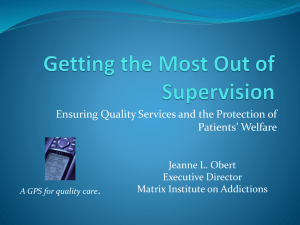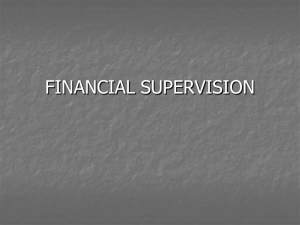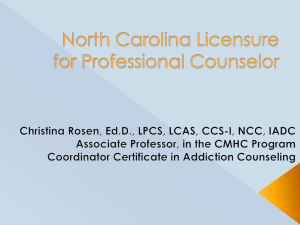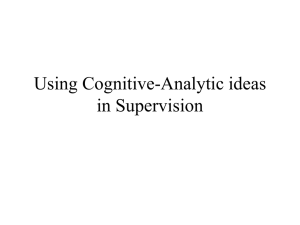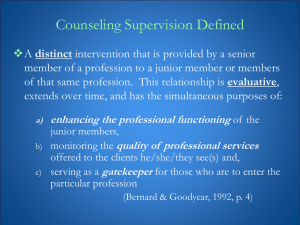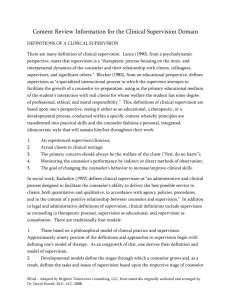the crisis line ate my homework and other fun stories from the life of
advertisement
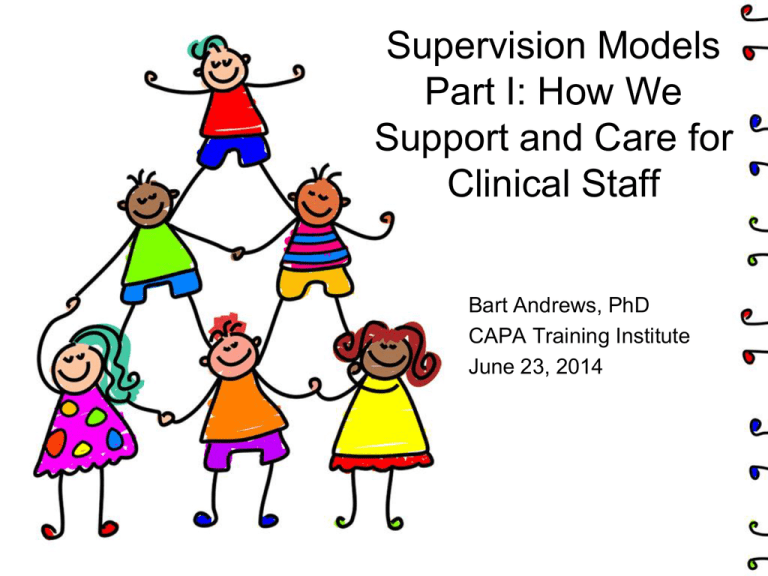
Supervision Models Part I: How We Support and Care for Clinical Staff Bart Andrews, PhD CAPA Training Institute June 23, 2014 Developmental Models • There are 3 stages of supervisor and supervisee development: – Stage 1- Naïve Enthusiasm – Stage 2- Trials and Tribulations – Stage 3- Calm after the Storm • Lets take a look at how these stages apply to my preparation. Naïve Enthusiasm Trials and Tribulations Calm after Storm Credit Where Credit Due “Powell is the man!”- David Patterson, June 17, 2014 BTW-why are there so many awesome Davids? Understanding Change • 30% of change is related to quality of relationship between client and counselor and/or counselor and supervisor • 40% from extratherapeutic factors • 15% is derived from hope/expectancy • 15% specific to therapeutic technique Relationship Drives EVERYTHING • Better Clinical Supervision = Greater Job Satisfaction • Better Clinical Supervision = Better Retention • Better Clinical Supervision = Better Clinical Outcomes “ . . .counselors view their supervisors as a primary resource for education, training, coaching, morale building and consultation,” (Powell and Brodsky, 2004). The 4 ‘A’s’ of Supervision • • • • Available Accessible Able Affable Good supervision is largely a matter of caring for staff and mutually beneficial interdependency Care Experiences • What care have you received from a supervisor? • What has a supervisor said (or not said) that has had the biggest impact on you? • What has a supervisor done (or not done) that has had the biggest impact on you? So What is a Model of Supervision? Philosophy Continuum Insight: Process, Goals, Traits • Experimentation • Exploration • Discovery • Interpretation • Self Development • Life Enrichment • Self Awareness • Facilitative • Client Driven Skill: Processes, Goals, Traits • Acquiring new behaviors • Action is the catalyst • Problem resolution • Symptom relief • Skill development • Problem oriented • Directive • Therapist Driven 9 Descriptive Dimensions • • • • • • • • • Influential: Symbolic: Structural: Replicative: Counselor TX: Information Gathering: Jurisdictional: Relationship: Strategy: Affective Vs Cognitive Latent Vs Manifest Reactive Vs Proactive Parallel Vs Discrete Related Vs Unrelated Indirect Vs Direct Therapist Vs Supervisor Facilitative Vs Hierarchical Theory Vs Technique STAGES OF DEVELOPMENT ALWAYS RELEVANT Psychodynamic Model • Focus on the intrapersonal and interpersonal dynamics of the counselor in relation to ALL others • Dynamic Awareness Goal: understanding dynamic contingencies: – Impact of past learning on current situations – Observing changes in the dynamic – Making therapeutic use of dynamic in counseling • Goal is to refine supervisee’s mode of listening – Increase sensitivity to transference and countertransference – Awareness of drives and defense mechanisms Assumptions • Similarities in structure and dynamics of therapy and supervision- ISOMORPHIC RELATIONSHIPS • Parallel processes between relationships • Supervisor interprets this dynamic • What is said and done is just the surface Supervisor Kkills(sorry, Freudian slip) I meant Skills • • • • • • Listening Musing Suspension of judgment Tolerance for ambiguity Rejection of illusion Think confession for therapists! Developmental Stages • Childhood – Space to play, home base – Bonding – Demarcating space • Adolescence – Structure building – Work and play-experimentation – Conflict • Adult – Internalized values – Identity settles – Transition to colleague Descriptive DimensionsPsychodynamic • • • • • • • • • Influential: Symbolic: Structural: Replicative: Counselor TX: Information Gathering: Jurisdictional: Relationship: Strategy: Affective Latent Reactive Parallel Related Indirect+ Therapist+ Facilitative Theory+ Skills Model 3 Basic Tenets 1) Counselors must learn the appropriate skills and extinguish inappropriate behaviors 2) Supervision assists counselors in developing and assimilating specific skills 3) Counselor knowledge and skills should be formulated in behavioral terms 9 Methods of Skill Supervision 1. Establishing a Relationship between supervisee and supervisor is a dynamic component of the learning process – Focus is on skill acquisition via instruction and modelling 2. Supervision begins by asking what one needs to lean to be an effective counselor – Current skill level? What skills are needed? Task list? 3. Set realistic, measurable and timely goals to enhance motivation – Is this reminding anyone of SMART goals and MI? Methods Continued 4. Modeling and reinforcement are basic tools – Two way modeling: supervisor to supervisee and back again 5. Skills monitoring is ongoing Methods Continued 6. Role Playing and Simulation 7. Microtraining-breaking down skills into small steps – – Simulated session that is video taped Supervisor provides feedback and re-demonstrates on tape 8. Other Techniques are added – – – Self management Overt and covert stimulus control Relaxation Training 9. Generalization of Skills – In what other situations might you use . . . Task Oriented Model Taking Supervision to Task • Drawn from behavioral and computer science models • Behavioral variables are manipulated to influence outcome of supervision • By reinforcing the variables of counselor behavior, supervisor can train more effective counselors • Not specific to any theoretical models • Tasks and reinforcement/shaping can be applied to specific skills for whatever model or technique an agency is using Direct Observation • Direct viewing of work is key • Modeling, feedback and programmed interventions • Using live material for supervision Hierarchical System/3 Levels/Parallel Activity Client level 1. Client database-what is going on with me 2. Client comes with set of hopes/goals 3. Make goals overt 4. Establish treatment plan 5. Put treatment in place 6. Goals met 7. Termination Counselor Level 1. Preparation 2. Establish client data base/evaluation-what is going on with client 3. Determine goals 4. Develop treatment plans 5. Carry out treatment plans 6. Evaluate progress 7. Goals met 8. Termination procedures Supervisor Level 1. 2. 3. 4. 5. 6. 7. Supervisor and Client Database-what is going on with them? A. Supervisor preparation task B. Determine supervisee’s preparation task Determine Supervision goals Supervision Plan A. Determine Assessment Procedures B. Determine Observation Procedures C. Present Supervision Plan Observe Therapist A. Observe Delivery B. Observe Impact Evaluate and Intervene A. Case file and assessment results B. Interview with Counselor Determining Counselor Progress A. Update counselor database B. Determine need for additional training/supervision End Supervision Developmental Stages-Skills • Apprentice – Motivated – Inwardly insecure/anxious – Eager to please • Journeyman – Demonstrates some skill – Some challenging behavior – Starting to generalize • Expert – Able to generalize across contexts – Mastered technical skills – Integrated personal model of therapy Descriptive Dimensions-Skills • • • • • • • • • Influential: Symbolic: Structural: Replicative: Counselor TX: Information Gathering: Jurisdictional: Relationship: Strategy: Cognitive Manifest Proactive Discrete Unrelated Direct Supervisor Hierarchical Technique Descriptive Dimensions, Really? • • • • • • • • • Influential: Symbolic: Structural: Replicative: Counselor TX: Information Gathering: Jurisdictional: Relationship: Strategy: Dynamic Skill Affective Latent Reactive Parallel Related Indirect+ Therapist+ Facilitative Theory+ Cognitive Manifest Proactive Discrete Unrelated Direct Supervisor Hierarchical Technique What’s Next: Blended Model • Blended Model acknowledges that substance use providers need their own model • Also called contemplative because it includes spiritual and faith based elements • Recognizes that successful supervision BLENDS both insight and skill based models • Philosophical model is evidence based AND consistent with substance use professionals training and agency goals COMING SOON TO A CAPA NEAR YOU


